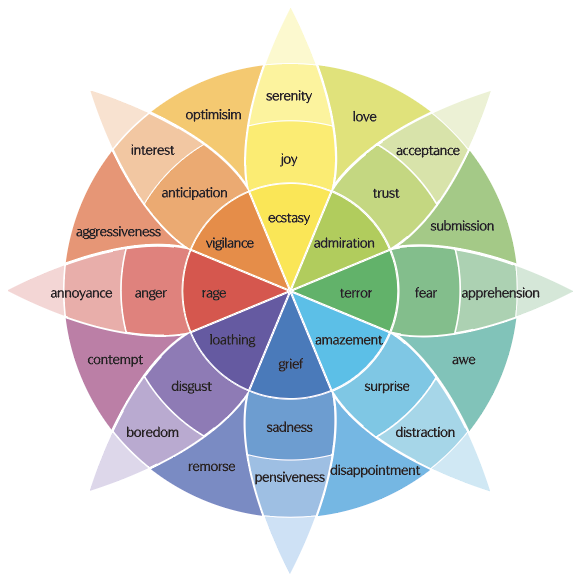Get to grips with your emotional landscape with the help of this effective tool
The feelings wheel is a visual tool that covers a variety of emotions that a human can experience. Awareness of it can help deepen your understanding of complex emotions, offer ways to describe your emotional weather, and aid you in healthy communication with others.
While there are lots of different ‘feelings wheel’ examples, the most famous is the Plutchik wheel, created by psychologist Robert Plutchik. The wheel breaks down eight core emotions into polarising pairs: anger/fear; disgust/acceptance; joy/sadness; and expectation/surprise.
In this theory, emotions move up and down a spectrum of intensity, with emotions on the outer edges feeling milder, while those in the centre are more intense. It’s worth noting that emotions that sit close together on the wheel have more in common, which is why it might be hard to find just one word to define how you feel. But if you’re keen to learn more and broaden your emotional horizons, here are five ways you can use the feelings wheel to benefit you...
1. Identify how you feel
The simplest way to get started with the feelings wheel is to use it as a way to give voice to your emotions. This can be helpful if you get frustrated about being unable to pinpoint your mood.
Start by scanning over all the emotions on the wheel, and settle on the one closest to how you feel. There is no right answer here; the wheel is a springboard for you to dive into the complexity of your emotions.
Try writing the word down, and using it as a way to validate your own experience. Alternatively, think about how you would comfort someone else who is feeling this emotion.
When you have words to label how you feel, it can take you out of your emotional brain and into your logical brain, which adds a degree of separation – and the opportunity to see your emotions from a different perspective.
2. Communicate with others
If you want to open up to someone about your mental health, but struggle to find the right words, try looking at the feelings wheel before you start. Pick out the emotion closest to the one you’re feeling and tell a friend. If you’re going through a period of grief, your friends may not know that your most intense feeling today is fear. Once you can articulate this, your friends can get a deeper understanding of your pain, and be more equipped to offer support.
Getting familiar with the feelings wheel can also give you a wider understanding of how others might feel, so when you are talking to someone, give them space to explore the nuances of their emotional experience in a non-judgemental way.
3. Identify triggers
Have you had an emotional reaction that seemed disconnected from what was actually happening? Perhaps accidentally burning your toast has sent you into floods of tears, or you’ve had a blank reaction to bad news. Giving words to these emotions can help you delve deeper into your inner world, and understand your triggers better. For example, someone with PTSD might find silence scary. Naming this emotion can give them a way to explore the root cause with a professional therapist, and work towards finding healthy coping mechanisms.

4. Make positive changes
Once you’ve identified how you feel, you can use the feelings wheel as a tool for change. If you’ve argued with your colleague, you might say you feel angry. Search around the wheel for your desired emotion, the one that you’d like to cultivate in response. Perhaps you gravitate towards acceptance, which offers you a chance to explore the feelings around this, such as trust, love, and submission. Can you use these feelings to inspire an action or series of actions that could resolve the conflict and help you process anger?
5. Track your emotions over time
When you’re emotionally overwhelmed it can seem never ending. Using the feelings wheel to give a name to your mood on a daily basis can, over time, give you paper evidence that no feeling lasts forever. Additionally, regular journaling about difficult emotions that persist will allow you to see areas of your mental health that could benefit from professional support.
For example, after journaling on your emotions for six weeks, you may feel proud that you managed to ride through the sadness of a romantic break up, but notice that rage is a feeling that has persisted. That might be something you want to discuss with a trained therapist.
While the feelings wheel is a helpful resource, don’t get too hung up on where you fit into the wheel. It’s just a starting point, and the most important thing is that you avoid bottling up your feelings, and instead find ways to investigate and express them in a therapeutic way.


Comments